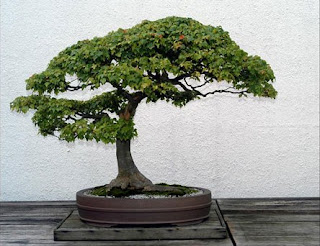I am always interested in tiny things, especially in nature.
But I think tiny things are absolutely amazing when they combine nature and artifice.
Bonsai are full grown trees and shrubs in miniature. They encourage us to get up close and personal to examine their textures, colors and shapes. These lovely examples come from the C.V. Starr Bonsai Museum at the Brooklyn Botanic Garden.
Bonsai specimens continue to grow, age and respond to changes in the seasons, but they must be constantly nurtured and constantly kept in check. Some plants can be maintained for centuries. This Japanese White Pine (Pinus parviflora), from the National Bonsai and Penjing Museum at the U.S. National Arboretum, dates from 1626 and was given to the Museum in 1976.
And this gorgeous Trident Maple (Acer buergeranum), also at the Arboretum, was started in 1880.
One of my favorite photographers is French-born-and-raised Didier Massard. He photographs breathtaking beautiful landscapes that are amazingly “real” and otherworldly but completely artificial. He painstakingly builds models of imaginary gardens…
remote corners of the world…
regal animals,
and then photographs them. Didier’s work has been described as “romantic”, “nostalgic”, “dreamlike fairy tales”, and of course, it is. But it is also a vocation and a discipline. A few photographs can take years to complete. He is always working to create an image and a history that both draw us in and transport us… not unlike the artists who create bonsai.
Didier is represented by the Julie Saul Gallery in New York and the Robert Klein Gallery in Boston. If his photographs are a little out of your budget, as they are mine, you might want to look at his two books: Artifices and Images.
Another interesting photographer is Joachim Knill. Joachim was born and raised in Switzerland but came to the U.S. to study art and live. He uses natural and found materials like seeds, nuts, sticks, fruits, vegetables and fabric to create much more surreal and whimsical landscapes and dioramas. He then photographs them with a huge portable instant film camera he designed and built himself. It is essentially the world’s largest Polaroid camera that enables him to experiment with light and exposure, and the photographs produced are 20” x 30”!
I actually own very small photographic reductions of some of Joachim’s photos:
The images are about 4” x 8”, and I really enjoy their tininess. They remind me of the long artistic tradition of small landscapes, often etched or painted… or photographed, over the centuries. But they also break from that tradition with their silliness and fantasy.
Who knows what we will see when we notice tiny things, right?

















No comments:
Post a Comment
Note: Only a member of this blog may post a comment.